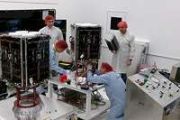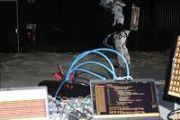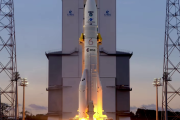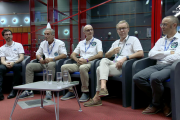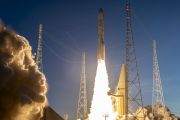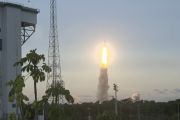
Copernical Team
Life support cooked up from lunar rocks
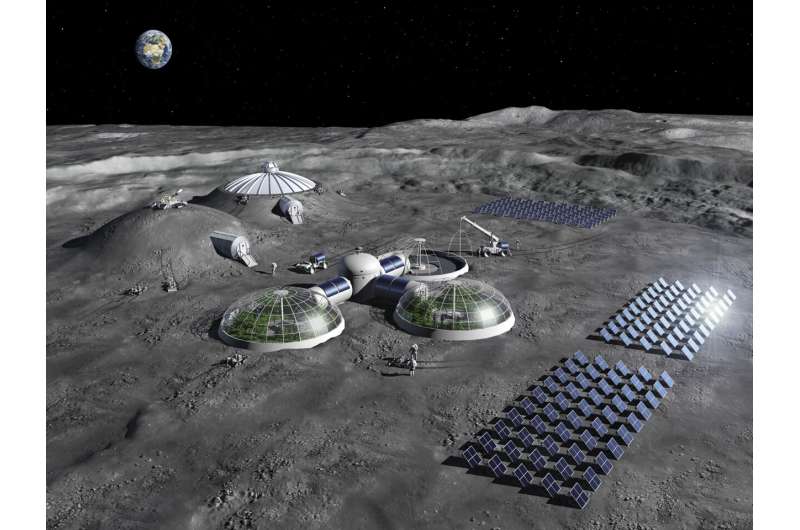
Engineers have successfully shown how water and oxygen can be extracted by cooking up lunar soil, in order to support future Moon bases. A laboratory demonstrator, developed by a consortium of the Politecnico Milano, the European Space Agency, the Italian Space Agency and the OHB Group, is presented this week at the Europlanet Science Congress (EPSC) 2021.
The set-up uses a two-step process, well known in industrial chemistry for terrestrial applications, that has been customized to work with a mineral mixture that mimics the lunar soil. Around 50% of lunar soil in all regions of the Moon is made up of silicon- or iron-oxides, and these in turn are around 26% oxygen. This means that a system that efficiently extracts oxygen from the soil could operate at any landing site or installation on the Moon.
In the experimental set-up, the soil simulant is vaporized in the presence of hydrogen and methane, then "washed" with hydrogen gas.
NASA Announces Virtual Webb STEAM Day Event for Students, Educators
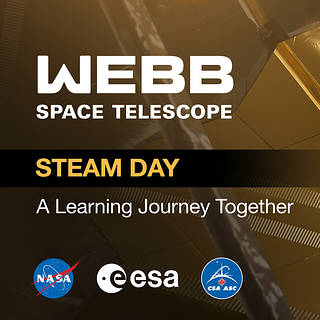 NASA invites learners of all ages, including students and teachers who recently returned to the classroom environment, to register for a special event ahead of the upcoming launch of the James Webb Space Telescope.
NASA invites learners of all ages, including students and teachers who recently returned to the classroom environment, to register for a special event ahead of the upcoming launch of the James Webb Space Telescope. NASA awards Orion Main Engine contract for future Artemis missions
 NASA has awarded a contract to Aerojet Rocketdyne Inc. of Redmond, Washington, for the development of the Orion Main Engine (OME), which will be used on the Orion spacecraft as part of the agency's Artemis program.
The contract includes certification of the OME design, production, and special studies and tasks. It is a single-award, indefinite-delivery/indefinite-quantity contract with fir
NASA has awarded a contract to Aerojet Rocketdyne Inc. of Redmond, Washington, for the development of the Orion Main Engine (OME), which will be used on the Orion spacecraft as part of the agency's Artemis program.
The contract includes certification of the OME design, production, and special studies and tasks. It is a single-award, indefinite-delivery/indefinite-quantity contract with fir Kendall presents unsparing blueprint for confronting China and other threats
 Department of the Air Force Secretary, Frank Kendall, offered a blunt and unsparing blueprint Sept. 20 for the Air and Space Forces, Congress and others to follow if they are to meet - and overcome - challenges to the nation's security posed by China and others.
Time is short, he said in a 30 minute, closely watched address to the Air Force Association's Air, Space, and Cyber Conference an
Department of the Air Force Secretary, Frank Kendall, offered a blunt and unsparing blueprint Sept. 20 for the Air and Space Forces, Congress and others to follow if they are to meet - and overcome - challenges to the nation's security posed by China and others.
Time is short, he said in a 30 minute, closely watched address to the Air Force Association's Air, Space, and Cyber Conference an Exploring quantum gravity-for whom the pendulum swings
 When it comes to a marriage with quantum theory, gravity is the lone holdout among the four fundamental forces in nature. The three others-the electromagnetic force, the weak force, which is responsible for radioactive decay, and the strong force, which binds neutrons and protons together within the atomic nucleus-have all merged with quantum theory to successfully describe the universe on the t
When it comes to a marriage with quantum theory, gravity is the lone holdout among the four fundamental forces in nature. The three others-the electromagnetic force, the weak force, which is responsible for radioactive decay, and the strong force, which binds neutrons and protons together within the atomic nucleus-have all merged with quantum theory to successfully describe the universe on the t Dashcam detective work leads to recovery of space rocks from fireball over Slovenia
 On 28 February 2020, at 10:30 CET, hundreds of people across Slovenia, Croatia, Italy, Austria and Hungary observed a bright ball of light hurtling across the morning sky. This delivery of rocks from a distant asteroid to the fields and villages of southern Slovenia was captured by cars' dashcams, security cameras, and even a cyclist's helmet.
It is one of only around 40 fallen space rocks
On 28 February 2020, at 10:30 CET, hundreds of people across Slovenia, Croatia, Italy, Austria and Hungary observed a bright ball of light hurtling across the morning sky. This delivery of rocks from a distant asteroid to the fields and villages of southern Slovenia was captured by cars' dashcams, security cameras, and even a cyclist's helmet.
It is one of only around 40 fallen space rocks US Space Force Commander claims Russia has armed satellite in orbit
 Russia already has deployed in low-earth orbit a "nesting doll" satellite armed with a weapon that can destroy US satellites vital for communications, command and control and precision targeting, Space Force Commander General John Raymond said on Tuesday.
"Russia has a nesting doll satellite [in orbit] to destroy US satellites, armed with a weapon to destroy US satellites," Raymond told th
Russia already has deployed in low-earth orbit a "nesting doll" satellite armed with a weapon that can destroy US satellites vital for communications, command and control and precision targeting, Space Force Commander General John Raymond said on Tuesday.
"Russia has a nesting doll satellite [in orbit] to destroy US satellites, armed with a weapon to destroy US satellites," Raymond told th CSO unveils Guardian Ideal, Space Force values at AFA
 Chief of Space Operations Gen. John W. "Jay" Raymond unveiled the Guardian Ideal and Space Force values during his speech Sept. 20, 2021, at the Air Force Association Air, Space, and Cyber Conference in National Harbor, Maryland.
The Guardian Ideal is the Space Force's foundational document outlining the service's boundary-pushing, innovative approach to talent management, from accession t
Chief of Space Operations Gen. John W. "Jay" Raymond unveiled the Guardian Ideal and Space Force values during his speech Sept. 20, 2021, at the Air Force Association Air, Space, and Cyber Conference in National Harbor, Maryland.
The Guardian Ideal is the Space Force's foundational document outlining the service's boundary-pushing, innovative approach to talent management, from accession t Glasgow Prestwick Spaceport announces Launch Partner
 Prestwick Spaceport has secured a launch partner for its spaceport development in a landmark deal that will boost Scotland's space industry ambitions and create an important strategic asset for the UK.
The spaceport, represented by Glasgow Prestwick Airport and South Ayrs0hire Council, yesterday signed a Memorandum of Understanding (MoU) with Astraius, the leading UK based, commercially op
Prestwick Spaceport has secured a launch partner for its spaceport development in a landmark deal that will boost Scotland's space industry ambitions and create an important strategic asset for the UK.
The spaceport, represented by Glasgow Prestwick Airport and South Ayrs0hire Council, yesterday signed a Memorandum of Understanding (MoU) with Astraius, the leading UK based, commercially op US Space Force to take over SATCOM operations from Army, Navy
 The U.S. Space Force will take over satellite communications billets, funding and mission responsibility from the U.S. Army and Navy, the Department of Defense announced Wednesday.
The transfer, which includes a total of 15 global units with 319 military and 259 civilian billets, is scheduled to be effective Oct. 1, if the Defense Department budget is passed and signed.
"We're on
The U.S. Space Force will take over satellite communications billets, funding and mission responsibility from the U.S. Army and Navy, the Department of Defense announced Wednesday.
The transfer, which includes a total of 15 global units with 319 military and 259 civilian billets, is scheduled to be effective Oct. 1, if the Defense Department budget is passed and signed.
"We're on 














